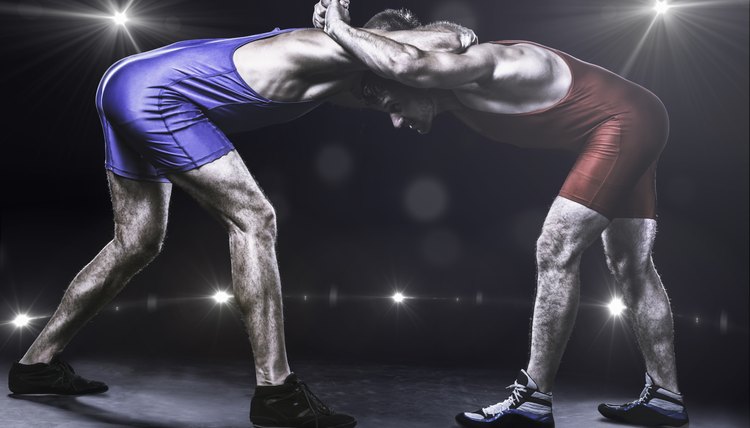Top 10 Moves to Do in Heavyweight High School Wrestling

High school heavyweight wrestlers often resemble college wrestlers in a variety of ways. They're larger than most of their classmates, often muscled more like a college student than a high school youth. Their larger bodies make some moves and strategies untenable. They can't rely on speed the way a 105-pounder can. This means adopting the simple, reliable moves often seen in college wrestling, where the skill levels mean fancier techniques simply don't work.
Hip Throw
Low takedowns are riskier for heavyweight wrestlers. A hip throw involves grabbing an opponent's upper body, then bumping his lower body with a hip to throw him over your hips and to the ground. This avoids having to go low with a takedown.
Head and Arm Throw
This is a variation of the hip throw, using the same basic mechanics of capturing the upper body and bumping with the hip. In an head and arm, the upper body capture places the opponent in a headlock while capturing the arm opposite your own. When you land this throw, your opponent will be on his back, stuck in a headlock you can use to affect a pin.
Fireman's Carry
One of the safest low-line takedowns, a fireman's carry starts with capturing an opponent's arm by the wrist. You then drop to your knees between your opponent's leg, lacing your other arm beneath this groin. When you pull on his arm and push on his hips, it will topple your opponent forward to the ground.
Sit-out Escape
This is one of the simplest and most common escapes from referee's position. It begins by leaning backward into your opponent while thrusting both feet forward until you're in a sitting position. From there, you can leverage yourself to your feed for a stand-up or reach behind to capture a leg and use a turn-in reversal.
Granby Roll
One of the more dynamic moves in a heavyweight's arsenal, this roll uses an opponent's weight against him. Used when you are on your hands and knees with your opponent on top of you, you perform it by capturing one of your opponent's arms, then doing a forward shoulder roll. If his weight is high enough, he'll roll with you and end up on his back with you lying on top of him.
Chest-to-Chest
A simple pinning technique that works better for heavier wrestlers, you do this move by lying perpendicular to your opponent with your chest tight against his. You can use your arms to capture his head or arm to prevent him from bridging. Your body weight will hold him flat long enough to get back points and maybe a pin.
Cradle
One of the most recognizable pinning combinations in wrestling, a cradle works as well for heavyweights as any other weight class. You start a cradle by wrapping one arm around an opponent's head and the other around one or both legs. Clasp your hands together, then roll your opponent onto his back.
Tight Waist
Also called a "deep waist," this move helps control an opponent from the "on top" position as he tries to escape. You simply wrap one arm around his stomach until you can grip his opposite ribs or armpit. This compresses his diaphragm while giving you a solid grip on his torso. Do not grab your opposite hand in a bear hug from this position -- it's an illegal hold.
Leg Ride
A leg ride rarely pins an opponent but will reliably roll him over to score near fall points. Start a leg ride from behind your opponent by slipping one leg between the legs of your opponent, then wrapping it to trap one of his legs. Then grip his head or shoulder and arch your hips forward. This stretches and immobilizes your opponent. At that point, you can roll him over onto his back.
Head and Arm Pin
You can enter this move from a head and arm throw or get into it from a ground wrestling position. With your back to your opponent's belly, slip your near arm around his head and grip his opposite arm. Roll him onto his back with your weight across his chest. Capturing the head and neck will prevent him from bridging out, placing him in a position for an easy pin.
Writer Bio
Jake Wayne has written professionally for more than 12 years, including assignments in business writing, national magazines and book-length projects. He has a psychology degree from the University of Oregon and black belts in three martial arts.
